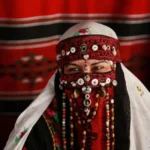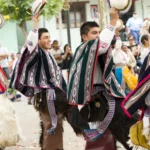Argentina, with its vibrant culture and diverse geography, showcases a remarkable array of traditional clothing that reflects its history, regional differences, and cultural identity. From the iconic gaucho attire to the elegant tango-inspired dresses, Argentina’s traditional attire embodies a blend of indigenous, European, and rural influences.
Historical and Cultural Roots of Argentine Traditional Clothing
The evolution of Argentina’s traditional clothing is deeply influenced by its indigenous heritage, European colonization, and rural lifestyle. These factors combined over centuries to produce garments that are both functional and symbolic.
Cultural Influences
- 🌎 Indigenous Contributions: The indigenous peoples of Argentina brought vibrant textiles, natural fibers, and intricate patterns to traditional clothing.
- 🇪🇸 Spanish Influence: Introduced elegant fabrics, embroidery, and refined tailoring during the colonial era.
- 🐎 Rural Gaucho Culture: The gaucho lifestyle shaped practical and durable clothing suitable for life on the Pampas.
Key Elements of Traditional Argentine Clothing
For Women
- 💃 Tango Dresses: Sleek, form-fitting dresses often featuring slits, ruffles, and bold colors like red and black.
- 🧣 Rebozos: Traditional shawls worn for warmth and style, often made of wool or silk.
- 👗 Floral Skirts: Flowing skirts with vibrant patterns, inspired by rural traditions.
- 🧵 Embroidered Blouses: Featuring intricate designs, combining Spanish and indigenous artistry.
- 🩰 Dance Shoes: Sturdy, elegant footwear essential for traditional dances like tango and folklore.
For Men
- 🧥 Bombachas de Campo: Loose-fitting trousers tucked into boots, ideal for horseback riding.
- 🐎 Poncho: A versatile garment made from wool, often adorned with geometric patterns.
- 👒 Wide-Brimmed Hat: Essential for gauchos, offering protection from the sun.
- 👢 Leather Boots: Durable and stylish, suited for life on the Pampas.
- 🧣 Neckerchiefs: Often brightly colored, adding a touch of flair to gaucho attire.
Regional Variations in Argentine Traditional Clothing
Northwest Argentina
The Andean regions showcase indigenous-inspired attire, including polleras (layered skirts) and chullos (knit hats with ear flaps), often made with alpaca or llama wool.
Pampas
The gaucho outfit dominates, with its practical design tailored for cattle ranching and horseback riding.
See also Traditional Clothing of Egypt: A Timeless Blend of Heritage and Culture
Traditional Clothing of Egypt: A Timeless Blend of Heritage and CulturePatagonia
Patagonian clothing reflects the region’s cold climate, featuring thick woolen garments and sturdy leather boots.
Cuyo Region
Known for its vineyards, this region’s attire blends traditional gaucho clothing with lighter fabrics suitable for the warm climate.
Urban Centers
In cities like Buenos Aires, traditional clothing often takes a modern twist, incorporating elements like tango-inspired fashion into contemporary styles.
Traditional Clothing in Argentine Celebrations
Tango Festivals
Dancers wear stunning tango dresses and sharp suits, showcasing the elegance and passion of this iconic dance.
See also Traditional Clothing in Ecuador: A Tapestry of Heritage and Diversity
Traditional Clothing in Ecuador: A Tapestry of Heritage and DiversityFolklore Festivals
Events like the National Festival of Folklore in Cosquín feature performers in regional attire, celebrating Argentina’s rural heritage.
Gaucho Gatherings
Festivals like the Dia del Gaucho highlight the gaucho lifestyle, with participants dressed in traditional ponchos, bombachas, and boots.
Carnivals
In regions like Corrientes and Gualeguaychú, carnival costumes incorporate bright colors, feathers, and indigenous motifs.
Craftsmanship and Materials in Argentine Clothing
Textiles and Materials
- 🐑 Wool: Derived from sheep, alpacas, and llamas, it’s commonly used in ponchos and warm garments.
- 🌾 Cotton: Light and breathable, ideal for warm-weather clothing.
- 👜 Leather: Frequently used in gaucho boots, belts, and hats.
Techniques and Artistry
- Weaving: Indigenous communities produce handwoven textiles with intricate patterns.
- Embroidery: Floral and geometric motifs are a hallmark of traditional blouses and dresses.
- Dyeing: Natural dyes from plants and minerals create vibrant, eco-friendly colors.
Preserving and Reviving Argentina’s Traditional Attire
Artisan Communities
Support for local artisans ensures the continuation of weaving, dyeing, and embroidery traditions.
Cultural Festivals
Events like the Festival Nacional del Poncho celebrate the artistry and significance of traditional garments.
Modern Fashion Influences
Contemporary Argentine designers draw inspiration from traditional clothing, incorporating ponchos, leather accents, and tango aesthetics into their collections.
A Living Heritage of Elegance and Resilience
Argentina’s traditional clothing is a testament to its cultural richness and diversity. From the rugged charm of gaucho attire to the refined elegance of tango dresses, these garments continue to connect Argentinians with their history, offering a timeless celebration of identity and creativity.
